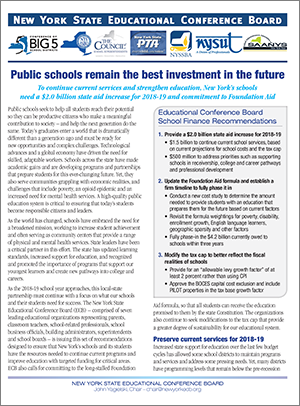Based on cost and tax cap projections, $1.5 billion in state aid needed just to continue current educational services for New York’s students
New York’s major statewide education organizations today released a new report that identifies the need for a $1.5 billion state aid increase to continue current services in 2018-19. The report recommends an additional $500 million in targeted funding to address pressing student needs and strengthen student achievement and opportunity.
 The report by the Educational Conference Board (ECB), entitled “Public schools remain the best investment in the future,” (PDF) also calls for phase-in of the Foundation Aid formula and enactment of tax cap modifications, both of which would enable school districts to conduct better financial planning.
The report by the Educational Conference Board (ECB), entitled “Public schools remain the best investment in the future,” (PDF) also calls for phase-in of the Foundation Aid formula and enactment of tax cap modifications, both of which would enable school districts to conduct better financial planning.
ECB Chair John Yagielski said, “We recognize warnings about the state’s fiscal challenges and acknowledge the level of uncertainty going into next year, especially due to developments at the federal level. However, state policymakers need to know what level of funding is needed to maintain current educational programs and services in our public schools and to foster student success. This report represents our best effort to identify the appropriate state education aid level for the 2018-19 school year.”
The estimated $1.5 billion in state aid needed to continue current services accounts for estimated growth in healthcare, pension costs, salaries and general inflation, based on cost projections from the State Division of Budget, Teachers Retirement Systems and others.
According to ECB’s analysis, total school spending would need to rise 2.8 percent next year to preserve current services.
Part of the cost increase would be funded by local revenue, which is constrained by the tax cap. If current inflation trends hold, allowable levy growth in the tax cap formula will be capped at 2 percent, or slightly lower. The $1.5 billion figure reflects the amount of state aid needed after accounting for local revenue.
Yagielski noted that the State Division of Budget’s mid-year financial plan update projects a $1.1 billion increase for schools in 2018-19.
In addition to the $1.5 billion needed to continue current services, other components of ECB’s recommendations include:
- FUNDING FOR PRIORITY AREAS: The overall funding recommendation includes $500 million in targeted funding for the following areas: assisting struggling schools; investing in professional development; meeting the needs of English language learners; strengthening college and career pathways after high school; and assisting districts with growing enrollments.
- FOUNDATION AID: ECB members call on the state to update the decade-old Foundation Aid formula based on current student needs and other factors, and establish a three-year timeline for full funding. The state is currently $4.2 billion behind the full phase-in amount.
- TAX CAP MODIFICATIONS: The report identifies tax cap changes designed to enable schools to do better planning on behalf of their communities. These include establishing an “allowable levy growth factor” of at least 2 percent and formula changes related to BOCES capital costs and PILOT agreements.
The report highlights the fact that schools are striving to meet increased expectations and have seen achievement gains. They are also experiencing an increase in a wide range of student needs. “Merely maintaining the status quo is not enough,” Yagielski said. “Preparing today’s students for success in a rapidly changing world requires a level of investment that enables schools to keep moving forward.”
In the report, ECB members credit state leaders with making education a priority in recent years, citing both funding and the focus on learning standards and pathways to the workforce and post-secondary education.
“The investments in education in recent years have been necessary and productive,” the report states. “The recommendations in this paper are designed to build on this progress by enabling schools to meet immediate needs, continue programs that are serving New York’s students, and strengthen education for all – those striving to meet higher expectations, those who are the most vulnerable, and those looking to take the next step into college or a career.”
-30-
The New York State Educational Conference Board is comprised the Conference of Big 5 School Districts; New York State Association of School Business Officials; New York State Council of School Superintendents; New York State PTA; New York State School Boards Association; New York State United Teachers; and the School Administrators Association of New York State.